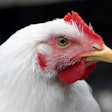
Animal welfare is becoming a critical issue for both poultry farmers and poultry producers. The elevated interest in welfare is pushing integrators and food retailers alike to join third-party welfare programs like the Global Animal Partnership.
The 10-year-old welfare program, administered by the eponymous non-profit organization based in Austin, Texas, is steadily gaining adherents in the broiler and turkey industries. Its partners in the broiler industry include: Allen Harim Foods, Farmers Pride Inc., Hain Pure Protein Corp.’s Freebird brand, Hormel Food Corp.’s Applegate Farms brand, Miller Poultry, Perdue Foods and Wayne Farms LLC.
Key planks of the GAP program – changing the environment inside the broiler house and potentially slowing growth rates – were discussed in depth as part of WATT Global Media’s panel discussion on measuring and improving broiler welfare. Appearing on the panel were: Jim Shepard, senior director live operations for Wayne Farms; Dr. Stephanie Torrey, senior research scientist for animal biosciences at the University of Guelph; Dr. Joy Mench, professor emeritus for animal science department at the University of California at Davis and Dr. Suzanne Dougherty, executive vice president of the American Association of Avian Pathologists and a consulting veterinarian with Pecking Around Consulting. The panel took place on February 1, 2018, as part of the 2018 International Production & Processing Expo in Atlanta.
Slowing down broiler growth rates
An emerging welfare issue, and one included in the GAP standards, is reducing broiler growth rates – or breeds scientifically proven to have markedly improved welfare outcomes. During the question and answer session, Leah Garces, U.S. executive director of Compassion in World Farming, asked Shepard a question about GAP implementation with a focus on slowing broiler growth rates. Garces is chair of GAP’s board of directors.
In September 2017, Wayne Farms launched its first product affiliated with the GAP welfare rating system. Its Naked Truth line of products are Step 2 rated – the second of six steps aimed toward eventually establishing an animal-centered production system where animals spend their whole lives on the farm. Wayne also produces conventionally raised, no-antibiotics-ever and vegetable-fed chicken products.
Shepard said Wayne Farms put its first slower-growing birds down in January 2018 and is testing to see what the impact of slower growth will be on its business. A loss of 17 to 20 points of feed conversion and 11 more days of grow-out needed before reaching slaughter weight are possible impacts. Slower growing birds will require more chicken houses, too.
‘We’ve gone backwards’
Shepard said he’s concerned about slower-growing genetics. First, the breeding decisions are being made today – separately of his operation – but won’t have any impact until five years later.
Second, there’s no guarantee a slower-growing breed will be as healthy and resilient as a conventional bird. Modern breeders are constantly improving bird health in general. There’s a comparatively much smaller pool of slower-growing genetics, he said. A small supply coupled with high demand means the integrator may be forced to go with a breed it’s not familiar with that’s more susceptible to disease and other health issues than the conventional breed.
“We’ve gone backwards,” Shepard said. “We’ve gone backwards on sustainability – 20 points feed conversion – and then we just went backwards on health, and we didn’t accomplish what we wanted for the bird.”
All the other parts of GAP, like adding enrichments and natural light, can be handled, Shepard said. Slower-growing genetics, however, will be harder to deal with.
“I just don’t think anyone’s really thought through the whole change in the slow-growing breeds,” Shepard said. “I’m not saying there shouldn’t be choices … but to attach that to GAP standards that come at the industry – that needs a lot more thought through that. And I don’t know why we can’t do it through combinations of feed restriction or feed density.”
Slowing growth through management?
Shepard said there are other ways to slow growth down besides modifying genetics. Feed density and feed restriction are possible methods. In New Zealand, for example, three-fourths feeding methods are used to control growth.
Mesch agreed that growth is not just about genetics. There are ways to manage conventional breed birds so they grow more slowly and vice versa. She said the New Zealand example is early restriction of feeding and then compensatory growth at the end of the cycle. This practice can reduce leg and footpad dermatitis problems, too. She said focusing on welfare outcomes, instead of dictating genetics, may be a way forward with the slow-growing challenge.
Light and feed conversion ratio
The use of light in broiler environments, and the relationships between light levels, activity levels and, ultimately, feed conversion ratios was discussed by the panelists, too. GAP standards call for inclusion of natural light in the broiler house in its Step 2.
Shepard, speaking about Wayne Farms’ adoption of GAP standards, said increased light levels do increase activity but it comes with a significant drop in feed conversion ratio. Moving from 0.5 foot candles (FC) of light to 2 FC costs three points of feed conversion. Increasing it further, to 5 FC from 2 FC, is another four points of feed conversion.
This is significant, Shepard said, because four points of feed conversion lost translates to about a million bushels of corn per year. That’s extra feed that needs to be grown, purchased, and transported by train from the Midwest to the South, which raises questions about sustainability. More scientific research is needed to define what lighting is best for both welfare and operational sustainability.
“We cannot go overboard too much so that we waste the sustainability,” Shepard said. “Whatever we do, I’m all for animal welfare and we’ll balance it, but just to swing the pendulum, so to speak, farther than what we need to has implications for sustainability and that concerns me.”
Wayne also noticed more scratching and cuts on the bird when it first increased the intensity of its lighting, but it was able to counteract it by changing its feed formulation to increase the protein level which improved feather coverage.
The role of natural light
As for the inclusion of natural light in the poultry house, Mench said she’s unsure if there’s ever been a direct comparison, but with light emitting diodes (LED) it should be possible to simulate the full spectrum of light provided by the sun. The full spectrum is important for the birds since their vision is different than humans and birds can see ultraviolet markings that humans can’t.
It should be possible to duplicate natural light in the poultry house using LED lights. Producers and researchers also must consider what welfare impact comes from having full intensity light coming from a window and, therefore, lower intensity darker areas, versus uniform lighting coming from artificial sources.
While discussing lighting, Shepard said it’s critical to remember the impact changes have on the grower.
“We can’t just flippantly change these houses. These are 50 year investments for these growers,” Shepard said. “Now we’re looking at going in there and cutting some holes, trying to get some natural light. If it’s better that’s great, but that’s another $18,000 to $15,000 (investment).”
The future of lighting in the broiler house
Mench said there is a fair amount of lighting studies conducted focusing on incandescent or florescent lighting. Now, many farmers are moving to LED lighting technology. LED presents much more potential in its ability to provide a full spectrum of light – birds see light differently than humans – and Mench said the full spectrum of light could possibly bring huge advantages for the birds. However, it’s not well understood how birds perceive LED light.
Another key aspect of welfare related to lighting, Mench said, is the lack of attention toward the need for a true, dark period of night in the poultry house. Researchers are focused on one aspect of lighting, when they should be thinking more broadly about lighting for different times of day and the effect of the full light spectrum on the birds.
Missed the IPPE panel? Watch highlights from the discussion on-demand, including more information on the role lighting plays in the house here.


















